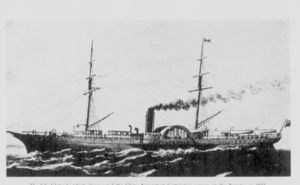Glengyle
Contents
History
March 13th.1864. Ordered for Robert Jardine, London. On trials attained a speed of 13.89 kts. at 18rpm. Delivered to Jardine Mathieson & Co. Hong Kong on Mar. 30th. She was an enlargement of their vessel Rona. She was initially built as a three masted barque.
March 1869. Conditional sale to Union S.N.Co. of Shanghai.
March 1872. Sold to Union S.N.Co. and placed on coastal work.
March 31st 1873, Taken over along with the Tunsin by the China Navigation Co. while awaiting delivery of four ships being built on the Clyde. Butterfield & Swire being appointed managers of the China Navigation Co. Vessels were employed on the Shanghai-Hankow sevice. The ship was now rigged as a brig, her mizzen mast having been removed.
November 9th. 1875. On a voyage to Amoy/Swatow the vessel struck rocks off Namoa Island, grounded, then slipped into off deep water and sank with heavy loss of life, 210 drowned.
Service
Events / Stories
There is a naughty story about the Glengyle and why she was built.
See here: http://gwulo.com/node/6173
On the 10th of May 1866 the London banking house of Overend Gurney refused payment. In other words, it collapsed, owing around eleven million pounds, or say a billion or two in current money. Overend Gurney had been the biggest discount house in London, known as "the banker's bankers" and it had been doing frightfully well until its directors made the classic banker's mistake of borrowing short and investing in illiquid assets, in their case not mortgages but mainly railway shares. The Directors of Overend Gurney appealed for help to the Bank of England, but since Gordon Brown was not Prime Minister in those days, and also perhaps because Overend Gurney had been behaving rather like competitors to the Bank of England, they were not bailed out, but allowed to sink.
The "run" on Overend Gurney was the last run on a British bank until just the other day, when we had the run on Northern Rock, which is something to reflect on, perhaps.
Anyway, the collapse of Overend Gurney had about the same impact on the financial markets of 1866 as the collapse of Lehman Brothers had on the financial markets of 2008.
News spread fast, and where there was a telegraph cable, it spread along the cable.
The telegraph cable to Hong Kong, however, stopped at Calcutta.
The Directors of the Princely Hong owned a paddle steamer named the "Glengyle".
She was a rather unusual ship; built in the days of low pressure (35lbs!) Scotch boilers and single expansion she consisted almost entirely of engine, boilers and coal bunkers - as a cargo carrier she was useless, and not much better for passengers.
This did not matter; her job in life was to sail from Calcutta one day after the mail steamer for Hong Kong, overtake it, arrive one day ahead of the mail steamer and sneak into Junk Bay, without clearing Customs. As she did so her Mate changed into his go ashores, jumped into a sampan and headed for the offices of the Princely Hong in Central, or Victoria as it then was, with the very latest news in his pocket. Once this was done, and once the mail steamer had arrived, but not before, she would up anchor, potter into harbour and clear Customs properly, soon after the mail steamer.
The Princely Hong learned of the collapse of Overend Gurney and withdrew their deposits, in gold, from the banks likely to be affected, one day before the news arrived.
Dents knew nothing of this, did not cash their deposits, and went bust when the banks collapsed.
The Princely Hong bought their offices and Hong Kong Land owns The Landmark to this day....
The "Glengyle" came to the end of her usefulness once the telegraph cable reached Hong Kong; she was sold to the Union Company and in due course the Great and Ancient Hong, which in those days was a Small and New Hong, bought the Union Company, and with it, her, as the first ship in their projected line of steamers, but they did not keep her long, as she ran on a rock and sank...

